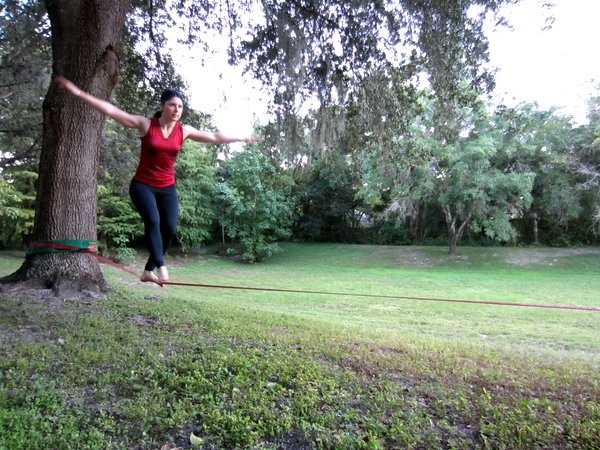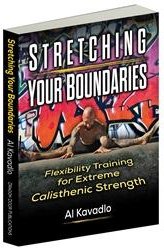
“Active Rest” is a phrase that we hear and say a whole lot without really thinking about it too much. On one hand the concept is extremely simple, a light workout day to speed recovery from a recent, more strenuous effort. But, some of us tend to over-complicate the issue and end up with a dauntingly over-engineered workout on what should be an opportunity for fun, meaningful practice, and optimized recovery.
Why not just be a couch potato?
It can be extremely tempting to just completely take some time off. And sometimes that’s necessary in cases of injury or really overdoing it in a workout. I’ve long held the belief that it’s better to err on the side of caution. Push and challenge yourself of course, but part of the learning process with the progressions in Convict Conditioning and the PCC is the self-knowledge that comes along with it. While coordination and proprioception are obvious mental “gains”, the value of learning your limits, and watching them change/improve should not be underestimated.
In our “gotta have it now” instant gratification culture, it’s sometimes difficult for those of us who are highly motivated to see the value in rest. More is always better, right? Not always! As I mentioned in a previous PCC Blog post about programming other modalities and interests with Convict Conditioning/PCC, Paul Wade’s routines like “Good Behavior” and “Veterano” (both outlined in the original Convict Conditioning book) provide plenty of rest and recovery time—as well as enough time to factor in a serious interest in sports, martial arts, etc.
How do you know that you’re not getting enough recovery time? Most people first notice when they’ve hit a plateau in their progress. While plateaus can result from many things (sometimes even psychological reasons!), it is easy enough to introduce more rest or active rest to your overall plan. Go getters and super motivated people who feel like they’ve stalled in their progress are especially encouraged to consider more rest. Similarly, I find that women who have fallen victim to the “must run/cycle/cardiostep to burn x calories or else” mindset can stall their strength and even weight loss efforts by not allowing time for recovery.
Active recovery is also really important as we get older. While I’m only just beginning to sneak up on 40, there’s definitely some changes I’ve had to make in my diet and rest schedule. I’m fond of saying that when we get older we don’t necessarily get weaker, we’re just no longer able to continue abusing our bodies. Both as we age and/or as our activity levels increase, it becomes even more important to pay attention to our self care and recovery. And at any age, paying attention to rest and recovery can certainly help prevent needless injuries.
Similarly, active recovery can also help us mentally recover from an all out effort or an intense week with workouts and with life.
So, after all this talk, what does an active recovery session look like? At its very simplest, an active rest day might include an extended stroll, especially if you’ve really had a tough week and workout. While I’m always up for a good walk, most of the time active recovery should involve a more than just wandering around the neighborhood.
Here are some of my favorite active recovery ideas, and I hope that you will add yours to the comments section below this blog post. After a long week, sometimes we all need help in the creative ideas department, so please be sure to share.
 Mobility or flexibility practice. Compared to most women, I’m reasonably inflexible (physically, let’s not talk personality) and consider it to be a challenging area. While I have no aspirations to become a contortionist or a yogi, some specific mobility and flexibility work would help my progress with a few calisthenics moves, and potentially provide additional injury prevention. While flexibility is an easy example of one of my own weak points, working on an appropriate shortcoming of your own can be a great basis for an active recovery day.
Mobility or flexibility practice. Compared to most women, I’m reasonably inflexible (physically, let’s not talk personality) and consider it to be a challenging area. While I have no aspirations to become a contortionist or a yogi, some specific mobility and flexibility work would help my progress with a few calisthenics moves, and potentially provide additional injury prevention. While flexibility is an easy example of one of my own weak points, working on an appropriate shortcoming of your own can be a great basis for an active recovery day.
A shorter/lighter version of a favorite workout, or a lighter version of a workout within your strength program. This is a great opportunity to fine tune your technique with some of the earlier progressions, since “lighter” in calisthenics doesn’t mean grabbing a lighter kettlebell or barbell. Many times some very important insights can come from a “regression-session” like this. If you’re an instructor you may also find some helpful hints for your clients or students you haven’t previously thought about.
Work on balance or a specific skill. One of my favorite recreational activities is slacklining. It points squarely at another one of my personal challenges, extreme balance! It’s a fun mental challenge and is oddly relaxing. It calls for focus and mental engagement, but without constantly tensing up the muscles (or you will fall down!) Even though I’m still very much a beginner, forcing myself to “go with the flow” during slacklining has actually helped me “accidentally” work through some muscle stiffness from tough workouts the day before!
Your tai chi or yoga practice (or an abbreviated version of it) might be another option as well. I have a favorite old qigong routine that I’ve practiced since 2000 that’s heavy on mindfulness and breathing, but light on the physical exertion. It’s been a big part of my warm up and active recovery for years, and I can definitely tell if I’ve slacked off of doing it! Similarly, less intense or short forms from tai chi as well as some of the more relaxing/meditative varieties of yoga would be good choices to consider.
Whether you are a type-a go-getter who hates the idea of taking a day off, someone who is stuck on a plateau, or simply someone who wants to maintain optimum health, adding gentle activity to your rest days can prove to be productive and fun.
***
About Adrienne Harvey, Senior PCC Instructor, RKC-II, CK-FMS, Primal Move Nat’l Instructor: Originally RKC Certified in 2010, and RKC Level 2 certified in 2011, kettlebell and bodyweight training have been crucial in Adrienne’s personal quest for fitness. A core member of the PCC team, Adrienne loves sharing her knowledge with small groups and individuals. She also loves to develop recipes and workout programs to further support performance, body composition, and of course—FUN. Go to http://www.giryagirl.com for more information about Adrienne!
